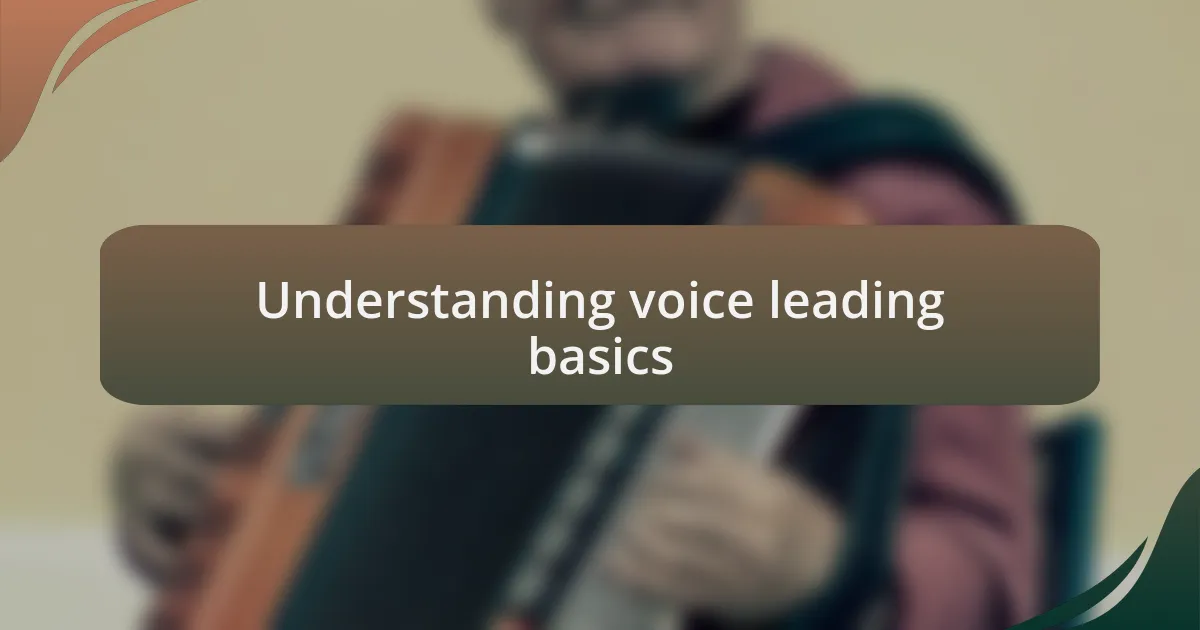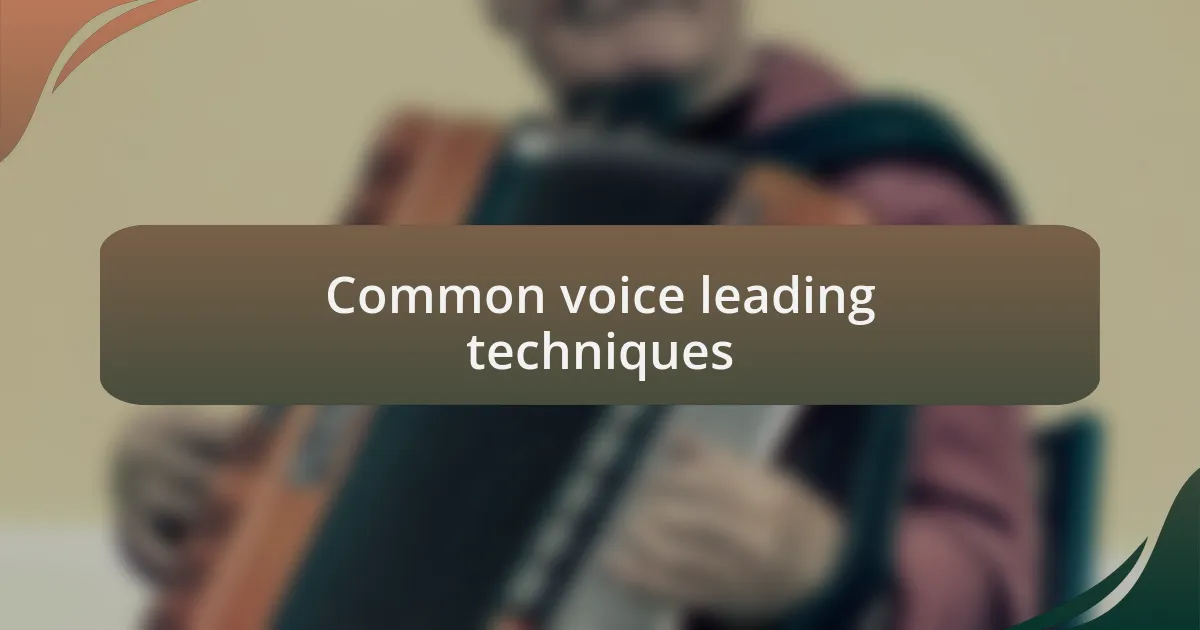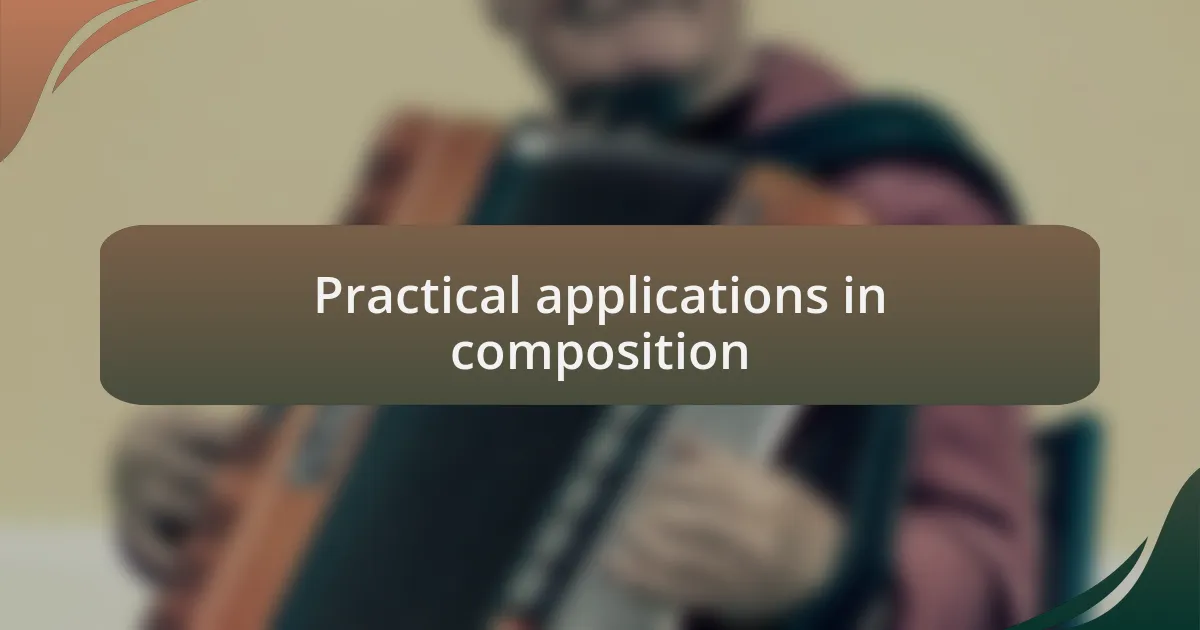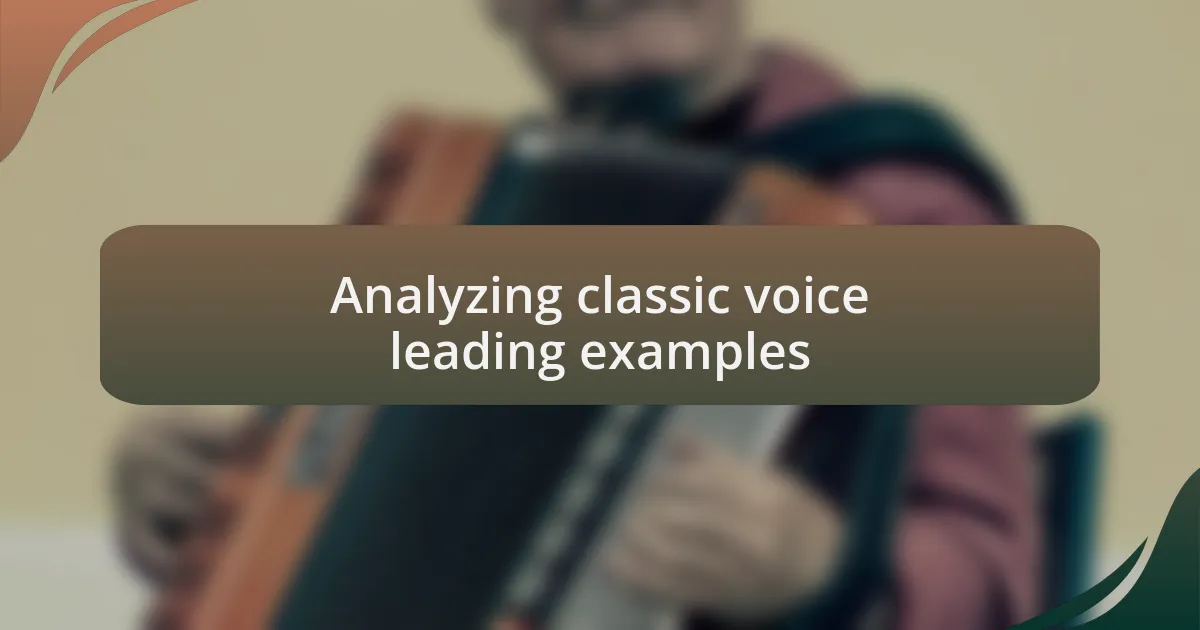Key takeaways:
- Voice leading enhances composition by ensuring smooth transitions and independence among melodic lines, creating emotional depth in music.
- Common techniques include using common tones for continuity, contrary motion for dynamic contrast, and voice crossing for unexpected harmonies.
- Practical applications of voice leading in composition can transform pieces, allowing for innovative emotional expressions through careful harmonic shifts and spacing.
- Classic examples, such as Bach’s chorales, demonstrate effective voice leading strategies like avoiding parallel fifths and utilizing dissonance to elevate emotional impact.

Understanding voice leading basics
Voice leading is one of those fundamental concepts in music that can truly elevate your compositions. It’s about how individual melodic lines move from one note to another, creating harmony without jarring transitions. I remember the first time I consciously paid attention to voice leading; it was like discovering a hidden layer in music that makes everything feel more connected.
When we talk about voice leading, we must consider the smoothness of these transitions. Think about it—how often have you heard a piece where the flow felt right? It’s usually a product of careful voice leading decisions. I’ve spent hours analyzing scores, and I noticed that composers often make deliberate choices to ensure each voice follows a logical path, minimizing leaps and awkward intervals.
Understanding the basics also involves grasping the concept of independence among voices. Each line should shine on its own while still contributing to the overall harmony. It’s fascinating to realize that this independence can create emotional depth, allowing a piece to feel both unified and diverse. Have you ever felt a particular thrill when a melody interacts seamlessly with a counterpoint? That’s the power of effective voice leading at work.

Common voice leading techniques
One common voice leading technique is the use of common tones between chords. When I first experimented with this method, I found that retaining specific notes while changing chords created a sense of continuity throughout a piece. This approach not only enhances the listening experience but also allows musicians to navigate transitions more smoothly. Have you ever noticed how a single note can tie a musical phrase together? That’s the magic of common tones in action.
Another technique is contrary motion, where voices move in opposite directions. I recall a composition where I intentionally employed contrary motion, and it was eye-opening to see how effectively it heightened the overall tension and release within the music. This technique not only creates a dynamic contrast but also keeps the listener engaged. It raises a question: how do you think the listener’s perception shifts when melodies move apart instead of together?
Finally, the concept of voice crossing can add an intriguing layer to your music. I’ll never forget the moment I realized how effective it could be—placing one voice above another can create unexpected harmonies and fresh perspectives. It forces the ear to adjust and can evoke strong emotional responses. Have you ever experienced that delightful surprise when a melody breaks conventional patterns? That’s the thrill of crossing voices, making your music feel alive and unpredictable.

Practical applications in composition
Incorporating voice leading techniques into composition can truly transform the way a piece feels. I remember a time when I deliberately applied voice leading principles to a piece I was working on, using smooth voice leading to guide the listener through contrasting sections. The resulting blend of harmonic shifts created an emotional landscape that felt both familiar and refreshing, provoking memories and imaginations. Have you ever tried playing with harmonic shifts to evoke a specific mood in your music?
When I explore chromatic voice leading, it often leads to unexpected delights. In one project, I altered a simple melody by introducing chromatic steps between key notes, which added tension and an uncanny beauty to the piece. This subtle yet powerful tool allowed me to explore different emotional depths—striking a delicate balance between familiarity and intrigue. Can you recall a moment in your compositions when a small tweak made a significant impact?
Utilizing spacing between voices is another practical application I find invaluable in my writing process. I’ve experimented with widening the intervals in my harmonies, creating an airy, uplifting quality that’s hard to resist. This approach not only invigorates the texture of the music but also invites listeners to immerse themselves in the sonic experience. Have you noticed how the space between notes can alter the overall atmosphere of your compositions?

Analyzing classic voice leading examples
When I examine classic examples of voice leading, I often return to Bach’s works, particularly his chorales. His skillful use of contrary motion between voices truly captivates me. I remember sitting at the piano, playing through one of his chorales, and feeling how the smooth transitions between the upper and lower voices created a sense of unity and tension that pulled me in. Have you ever noticed how these subtle shifts can evoke such powerful emotions?
In my explorations of traditional voice leading, I’ve found that avoiding parallel fifths and octaves fosters a richer, more textured sound. I vividly recall a moment when I emulated this practice in a composition, consciously ensuring that each voice maintained its independence. The result was a complex, yet cohesive sound that was both satisfying and engaging. Can you think of a situation where adhering to these classic rules made a difference in your own musical creations?
Another fascinating aspect I’ve encountered in analyzing classical examples is the strategic use of dissonance. When I studied how composers like Mozart navigated these moments, I was amazed by their ability to resolve tension elegantly. As I experimented with similar techniques in my own work, I discovered that carefully placed dissonances can heighten emotional impact. Have you explored how dissonance in voice leading can transform the listener’s experience?